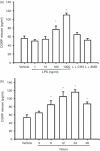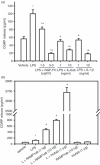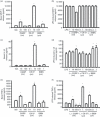Lipopolysaccharide induces calcitonin gene-related peptide in the RAW264.7 macrophage cell line
- PMID: 20141542
- PMCID: PMC2913219
- DOI: 10.1111/j.1365-2567.2009.03239.x
Lipopolysaccharide induces calcitonin gene-related peptide in the RAW264.7 macrophage cell line
Abstract
Calcitonin gene-related peptide (CGRP) is widely distributed and plays important roles in a wide array of biological functions. It is enriched in primary sensory neurons and hence involved in nociception and neurogenic inflammation. Recent studies have shown that CGRP can be produced by immune cells such as monocytes/macrophages following inflammatory stimulation, suggesting a role in innate immunity. However, it is unclear how CGRP is up-regulated in macrophages and if it plays a role in macrophage functions such as the production of cytokines and chemokines. Using enzyme-linked immunosorbent assay (ELISA) and multiplex ELISA, lipopolysaccharide (LPS) was found to induce CGRP in the RAW 264.7 macrophage cell line. LPS-induced inflammatory mediators such as nerve growth factor (NGF), interleukin-1beta (IL-1beta), IL-6, prostaglandin E(2) (PGE(2)) and nuclear factor-kappaB (NF-kappaB) signalling are involved in inducing CGRP, whereas the NGF receptor trkA and CGRP receptor signalling pathways are unexpectedly involved in suppressing LPS-induced CGRP, which leads to the fine-tune regulation of CGRP release. Exogenous CGRP and CGRP receptor antagonists, in a concentration-dependent manner, stimulated, inhibited or had no effect on basal or LPS-induced release of monocyte chemoattractant protein-1, IL-1beta, IL-6, tumour necrosis factor-alpha and IL-10 in RAW macrophages. The ligand-concentration-dependent regulation of the production of inflammatory mediators by CGRP receptor signalling is a novel mechanism underlying the stimulating and suppressing role of CGRP in immune and inflammatory responses. Together, our data suggest that monocytes/macrophages are an important source of CGRP. Inflammation-induced CGRP has a positive or negative reciprocal effect on the production of other pro- and anti-inflammatory mediators. Thereby CGRP plays both facilitating and suppressing roles in immune and inflammatory responses.
Figures





Similar articles
-
Calcitonin gene-related peptide modulates the production of pro-inflammatory cytokines associated with periprosthetic osteolysis by THP-1 macrophage-like cells.Neuroimmunomodulation. 2015;22(3):152-65. doi: 10.1159/000360988. Epub 2014 May 14. Neuroimmunomodulation. 2015. PMID: 24853723
-
Calcitonin gene-related peptide potentiates LPS-induced IL-6 release from mouse peritoneal macrophages.J Neuroimmunol. 1998 Apr 15;84(2):207-12. doi: 10.1016/s0165-5728(97)00257-9. J Neuroimmunol. 1998. PMID: 9628464
-
Nerve growth factor downregulates inflammatory response in human monocytes through TrkA.J Immunol. 2014 Apr 1;192(7):3345-54. doi: 10.4049/jimmunol.1300825. Epub 2014 Feb 28. J Immunol. 2014. PMID: 24585880
-
Calcitonin gene-related peptide (CGRP): A novel target for Alzheimer's disease.CNS Neurosci Ther. 2017 Jun;23(6):457-461. doi: 10.1111/cns.12696. Epub 2017 Apr 17. CNS Neurosci Ther. 2017. PMID: 28417590 Free PMC article. Review.
-
A comprehensive review on calcitonin gene-related peptide in the management of gastrointestinal disorders.Inflammopharmacology. 2025 Mar;33(3):1043-1059. doi: 10.1007/s10787-025-01657-6. Epub 2025 Feb 11. Inflammopharmacology. 2025. PMID: 39934537 Review.
Cited by
-
MerTK Downregulates Lipopolysaccharide-Induced Inflammation Through SOCS1 Protein but Does Not Affect Phagocytosis of Escherichia coli in Macrophages.Inflammation. 2019 Feb;42(1):113-123. doi: 10.1007/s10753-018-0877-5. Inflammation. 2019. PMID: 30143932
-
Nociceptor-Macrophage Interactions in Apical Periodontitis: How Biomolecules Link Inflammation with Pain.Biomolecules. 2023 Jul 31;13(8):1193. doi: 10.3390/biom13081193. Biomolecules. 2023. PMID: 37627258 Free PMC article. Review.
-
The metabolic syndrome alters the miRNA signature of porcine adipose tissue-derived mesenchymal stem cells.Cytometry A. 2018 Jan;93(1):93-103. doi: 10.1002/cyto.a.23165. Epub 2017 Jul 5. Cytometry A. 2018. PMID: 28678424 Free PMC article.
-
Calcitonin gene‑related peptide induces IL‑6 expression in RAW264.7 macrophages mediated by mmu_circRNA_007893.Mol Med Rep. 2017 Dec;16(6):9367-9374. doi: 10.3892/mmr.2017.7779. Epub 2017 Oct 12. Mol Med Rep. 2017. PMID: 29039515 Free PMC article.
-
Inhibition of lipopolysaccharide-induced microglia activation by calcitonin gene related peptide and adrenomedullin.Mol Cell Neurosci. 2011 Oct;48(2):151-60. doi: 10.1016/j.mcn.2011.07.006. Epub 2011 Jul 22. Mol Cell Neurosci. 2011. PMID: 21803157 Free PMC article.
References
-
- Amara SG, Jonas V, Rosenfeld MG, Ong ES, Evans RM. Alternative RNA processing in calcitonin gene expression generates mRNAs encoding different polypeptide products. Nature. 1982;298:240–4. - PubMed
-
- Brain SD, Grant AD. Vascular actions of calcitonin gene-related peptide and adrenomedullin. Physiol Rev. 2004;84:903–34. - PubMed
-
- Jacques D, Dumont Y, Quirion R. Calcitonin gene-related peptide (CGRP), amylin, and adrenomedullin: anatomical localization and biological functions in the mammalian and human brains. In: Quirion R, Bjorklund A, Hokfelt T, editors. Handbook of Chemical Neuroanatomy. Amsterdam: Elsevier; 2000. pp. 301–56.
-
- van Rossum D, Hanisch UK, Quirion R. Neuroanatomical localization, pharmacological characterization and functions of CGRP, related peptides and their receptors. Neurosci Biobehav Rev. 1997;21:649–78. - PubMed
-
- Amara SG, Arriza JL, Leff SE, Swanson LW, Evans RM, Rosenfeld MG. Expression in brain of a messenger RNA encoding a novel neuropeptide homologous to calcitonin gene-related peptide. Science. 1985;229:1094–7. - PubMed
Publication types
MeSH terms
Substances
Grants and funding
LinkOut - more resources
Full Text Sources
Molecular Biology Databases
Research Materials

